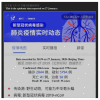Effects of Health Information Dissemination on User Follows and Likes during COVID-19 Outbreak in China: Data and Content Analysis
- PMID: 32674510
- PMCID: PMC7399940
- DOI: 10.3390/ijerph17145081
Effects of Health Information Dissemination on User Follows and Likes during COVID-19 Outbreak in China: Data and Content Analysis
Abstract
Background: COVID-19 has greatly attacked China, spreading in the whole world. Articles were posted on many official WeChat accounts to transmit health information about this pandemic. The public also sought related information via social media more frequently. However, little is known about what kinds of information satisfy them better. This study aimed to explore the characteristics of health information dissemination that affected users' information behavior on WeChat. Methods: Two-wave data were collected from the top 200 WeChat official accounts on the Xigua website. The data included the change in the number of followers and the total number of likes on each account in a 7-day period, as well as the number of each type of article and headlines about coronavirus. It was used to developed regression models and conduct content analysis to figure out information characteristics in quantity and content. Results: For nonmedical institution accounts in the model, report and story types of articles had positive effects on users' following behaviors. The number of headlines on coronavirus positively impacts liking behaviors. For medical institution accounts, report and science types had a positive effect, too. In the content analysis, several common characteristics were identified. Conclusions: Characteristics in terms of the quantity and content in health information dissemination contribute to users' information behavior. In terms of the content in the headlines, via coding and word frequency analysis, organizational structure, multimedia applications, and instructions-the common dimension in different articles-composed the common features in information that impacted users' liking behaviors.
Keywords: characteristic; content analysis; health information dissemination; novel coronavirus; official account; regression model; users’ information behavior.
Conflict of interest statement
The authors declare no conflict of interest.
Figures










Similar articles
-
Data Mining and Content Analysis of the Chinese Social Media Platform Weibo During the Early COVID-19 Outbreak: Retrospective Observational Infoveillance Study.JMIR Public Health Surveill. 2020 Apr 21;6(2):e18700. doi: 10.2196/18700. JMIR Public Health Surveill. 2020. PMID: 32293582 Free PMC article.
-
Conversations and Medical News Frames on Twitter: Infodemiological Study on COVID-19 in South Korea.J Med Internet Res. 2020 May 5;22(5):e18897. doi: 10.2196/18897. J Med Internet Res. 2020. PMID: 32325426 Free PMC article.
-
Public Engagement and Government Responsiveness in the Communications About COVID-19 During the Early Epidemic Stage in China: Infodemiology Study on Social Media Data.J Med Internet Res. 2020 May 26;22(5):e18796. doi: 10.2196/18796. J Med Internet Res. 2020. PMID: 32412414 Free PMC article.
-
Preprints During the COVID-19 Pandemic: Public Health Emergencies and Medical Literature.J Hosp Med. 2020 Oct;15(10):634-636. doi: 10.12788/jhm.3491. J Hosp Med. 2020. PMID: 32966198 Free PMC article. Review. No abstract available.
-
Epidemiological Features of the 2019 Novel Coronavirus Outbreak in China.Curr Top Med Chem. 2020;20(13):1137-1140. doi: 10.2174/1568026620999200511094117. Curr Top Med Chem. 2020. PMID: 32394842 Review.
Cited by
-
Perceived Information Overload and Unverified Information Sharing on WeChat Amid the COVID-19 Pandemic: A Moderated Mediation Model of Anxiety and Perceived Herd.Front Psychol. 2022 Feb 3;13:837820. doi: 10.3389/fpsyg.2022.837820. eCollection 2022. Front Psychol. 2022. PMID: 35185742 Free PMC article.
-
What social media told us in the time of COVID-19: a scoping review.Lancet Digit Health. 2021 Mar;3(3):e175-e194. doi: 10.1016/S2589-7500(20)30315-0. Epub 2021 Jan 28. Lancet Digit Health. 2021. PMID: 33518503 Free PMC article.
-
Middle-aged and elderly users' continuous usage intention of health maintenance-oriented WeChat official accounts: empirical study based on a hybrid model in China.BMC Med Inform Decis Mak. 2021 Sep 3;21(1):257. doi: 10.1186/s12911-021-01625-4. BMC Med Inform Decis Mak. 2021. PMID: 34479566 Free PMC article.
-
Information Dissemination Model in Rural Live Broadcasting under Blockchain in the Era of Artificial Intelligence.Comput Intell Neurosci. 2022 Jul 11;2022:4590578. doi: 10.1155/2022/4590578. eCollection 2022. Comput Intell Neurosci. 2022. Retraction in: Comput Intell Neurosci. 2023 Jul 26;2023:9845481. doi: 10.1155/2023/9845481. PMID: 35860641 Free PMC article. Retracted.
-
Online profiling of volunteers in public health emergencies: insights from COVID-19 in China.BMC Public Health. 2025 Jan 20;25(1):225. doi: 10.1186/s12889-025-21446-8. BMC Public Health. 2025. PMID: 39833777 Free PMC article.
References
-
- WHO . Novel Coronavirus (2019-nCoV) Situation Report-141. WHO; Geneva, Switzerland: 2020. [(accessed on 9 June 2020)]. Available online: https://www.who.int/docs/default-source/coronaviruse/situation-reports/2....
-
- Fox C.S., Barry K., Colbert J. Importance of Social Media Alongside Traditional Medical Publications. Circulation. 2016;133:1978–1983. doi: 10.1161/CIRCULATIONAHA.115.020303. - DOI
-
- CSM Media Research . Expectation Survey Report on Users’ Media Consumption and Use during the Epidemic. CSM Media Research; HongKong, China: 2020. [(accessed on 9 June 2020)]. Available online: http://www.csm.com.cn/Content/2020/02-25/1015314370.html.
-
- Zhao H. Wechat Annual Data Report in 2019. Fast Technology; St Mellons CF3, GB, USA: 2020. [(accessed on 9 June 2020)]. Available online: http://news.mydrivers.com/1/666/666552.htm.
Publication types
MeSH terms
Grants and funding
LinkOut - more resources
Full Text Sources

